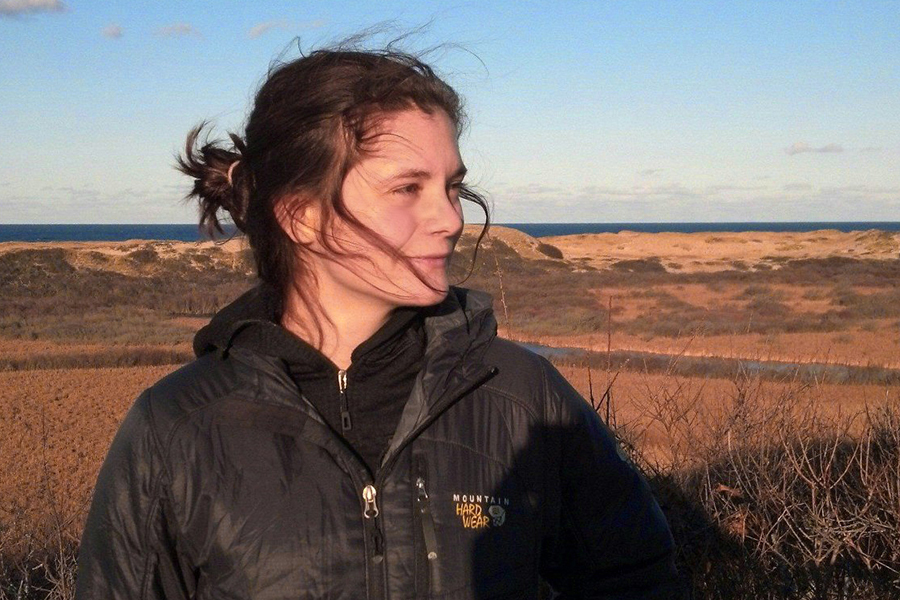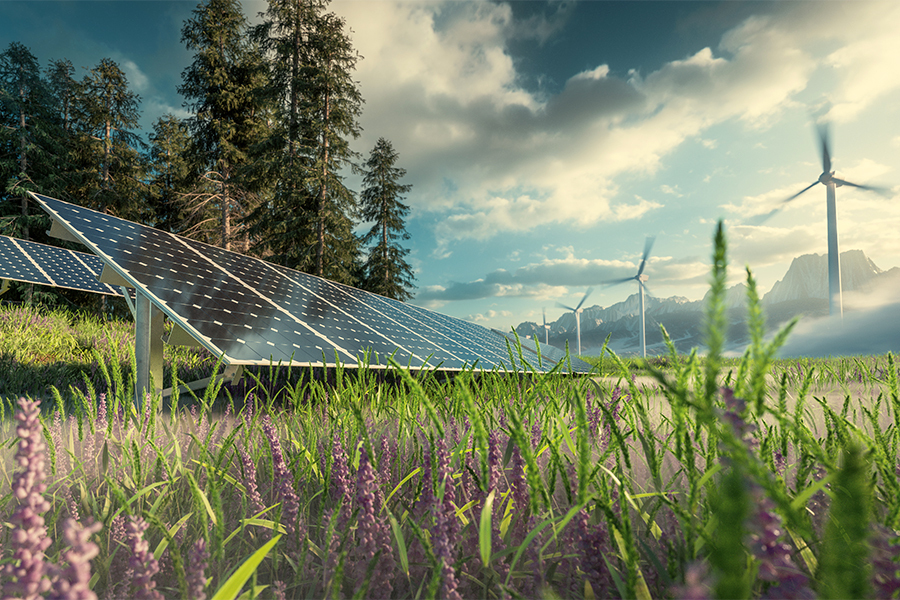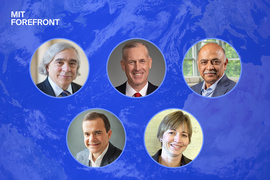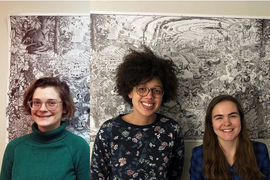Caroline White-Nockleby is a PhD student in MIT’s doctoral program in History, Anthropology, and Science, Technology, and Society (HASTS), which is co-sponsored by the History and Anthropology sections, and the Program in Science, Technology and Society (STS). White-Nockleby's research centers on the shifting supply chains of renewable energy infrastructures. In particular, she is interested in the interfaces between policymaking, social dynamics, and tech innovations in the sourcing, manufacture, and implementation of energy storage technologies. She received a BA in geosciences and American studies from Williams College and an MPhil in social anthropology from the University of Cambridge, England. MIT SHASS Communications spoke with her for the series Solving Climate: Humanistic Perspectives from MIT about the perspectives her field and research bring to addressing the climate crisis.
Q: How has research from the HASTS doctoral program shaped your understanding of global climate change and its myriad ecological and social impacts?
A: MIT HASTS alum Candis Callison [PhD ’10], now an anthropologist and professor of journalism, wrote her first book, “How Climate Change Comes to Matter” about the different discursive frameworks — what she terms “vernaculars” — through which scientists, journalists, Indigenous communities, sustainable investment firms, and evangelical Christian environmental organizations understand climate change.
Through ethnographic research, Callison shows that although these understandings were grounded in a shared set of facts, each drew from different cultural and ethical frameworks. These variations could silo conversations, even as they illustrated the pluralities of the climate crisis by highlighting different challenges and compelling different actions.
HASTS faculty member and environmental historian Megan Black, an associate professor in the MIT History Section, is currently researching the history of the first Landsat satellites launched in the 1970s. The technical capacities of Landsat’s visualization mechanisms were influenced by the political context of the Cold War. Black’s investigation has revealed, among other findings, that Landsat’s imaging devices were particularly well-suited to surfacing geological features and thus to minerals exploration, which was a key application of Landsat data in its inaugural decade. The historical context of the satellite’s initial design has thus shaped — and limited — the information accessible to the many investigations that today use early Landsat imagery as a vital indicator of decadal-scale environmental changes.
Climate change is not only a scientific and technological matter, but also a social, political, and historical one. It stems from centuries of uneven geographies of energy extraction and distribution; related historical and geographical processes today distribute climate vulnerabilities unevenly across places and people.
The dimensions of today’s promising interventions have, in turn, been configured by past funding and research agendas — and the many technologies employed have a wide variety of implications for equity, ethics, and justice. The parameters of public opinion and policy debate on the nature and risks of climate change, as well as its conceivable solutions, are similarly shaped by socio-historical contexts.
MIT's Program in History, Anthropology, Science, Technology and Society (HASTS) supports research that attends to the social and historical facets of climate change. Just as importantly, the HASTS program equips scholars with the tools to develop nuanced understandings of the scientific and technological mechanisms of its causes, impacts, and proposed solutions. Such technical and social attunement makes the program well-situated — perhaps particularly so — to unravel the myriad social and ecological dimensions of the climate crisis.
Q: Technology offers hope for addressing climate change, and it also presents challenges. The renewable energy industry, for example, relies on the mining of lithium and other metals — a process that is itself damaging to the environment. What has your research revealed about the trade-offs humanity is facing in its efforts to combat global climate change, and, how would you suggest we begin to grapple with such trade-offs?
A: Renewable energy can sometimes be positioned as immaterial and inherently redistributive. In some sense these characterizations arise from physical qualities: the sun and wind don’t require extraction, won’t run out, and are distributed across space.
Yet renewable energy must be collected, stored, and transported; it requires financing, metals extraction, and the processing of decommissioned materials. Energy access, mining, and waste deposition are material, geographically situated dynamics. Not everyone stands to benefit equally from renewable energy's financial and environmental potentials, and not everyone will be equally exposed to its socio-environmental impacts.
The distribution of burdens is in some cases already mapping onto existing inequities in power and privilege, disproportionately impacting BIPOC [Black, Indigenous, and people of color] and low-income individuals, as well as communities in the Global South — often in locales also on the front lines of climate change or other forms of environmental injustice.
None of these challenges should stall renewable energy implementation; renewables are an absolutely crucial part of climate mitigation and can also increase climate resilience and reduce environmental contamination, among other co-benefits.
Moreover, neither the parameters of these challenges nor the potential interventions are clear-cut. Minerals extraction is key for many local economies.
Different metals also have distinct environmental and social footprints. Cobalt mining, which takes place largely in the Democratic Republic of the Congo under environmentally and economically precarious conditions, poses different socio-ecological challenges than copper extraction, which takes place around the world, primarily at large scales via increasingly remote methods. Lithium, meanwhile, can be found in salt flats, igneous rocks, geothermal fluids, and clays, each of which requires different mining techniques.
Minimizing the localized burdens of renewable energy implementation will be complex. Here at MIT, researchers are working on technical approaches to develop less-intensive forms of mining, novel battery chemistries, robust energy storage technologies, recycling mechanisms, and policies to extend energy access. Just as important, I think, is understanding the historical processes through which the benefits and burdens of different energies have been distributed — and ensuring that the ethical frameworks by which current and future projects might be mapped and evaluated are sufficiently nuanced.
I’m still in the planning phase of my own research, but I hope it will help surface, and offer tools with which to think through, some of these socio-environmental complexities.
Q: In confronting an issue as formidable as climate change, what gives you hope?
A: In college I did an interview project to learn about collaborations between student environmental groups and a local church to address climate change. Toward the end of each interview, I found myself coming back to the same question: What gives you energy in your work on climate change? What keeps you going?
The question wasn’t strictly necessary for my project; I was asking, mostly, for myself. Climate change can be truly overwhelming, in part because it so dramatically dwarfs the scope, in space and in time, of a single human life. It is also complex — intertwined with so many different ways of knowing the world.
My interviewees gave different answers. Some told me they were careful to mentally segment the issue so as to keep “climate change,” as a paralyzing totality, from sapping a sense of purpose from their daily research or advocacy endeavors. Others I spoke with took the opposite approach, conceptually linking their own efforts — which could feel insufficiently quotidian — to a sense of the broader stakes. But almost everyone I talked to highlighted the importance of being part of a community — of engaging in and through collaborative efforts.
That’s what gives me hope as well: people working together to address climate change in ways that attend to both its scientific and its social complexities. Intersections between climate change and social justice like the Sunrise Movement or the Climate Justice Alliance give me hope.
Climate-related collaborations are also happening all across MIT; I find the initiatives that have emerged from the Climate Grand Challenges process particularly inspirational. In STS, individuals such as HASTS alum Sara Wylie [PhD ’11], who has researched the impacts of hydraulic fracturing, have built deep relationships with the communities they work within, leveraging their research to support relevant climate justice initiatives.
For my part, I’ve been energized by my involvement in a project led by MIT MLK Scholar Luis G. Murillo [former minister of environment and sustainable development in Colombia] that convenes policymakers, community advocates, and researchers to advance initiatives that foment racial justice, conservation, climate mitigation, and peace.
Prepared by MIT SHASS Communications
Series editor and designer: Emily Hiestand
Co-editor: Kathryn O'Neill











